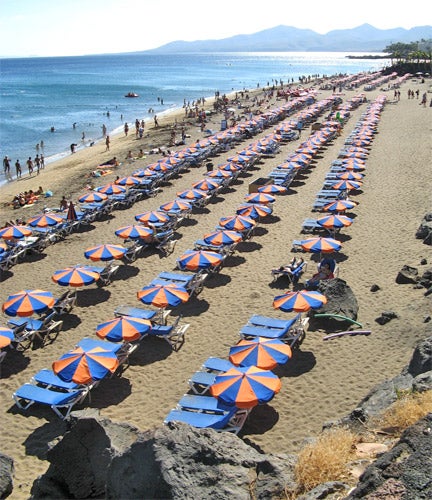Building craze threatens to end Lanzarote's biosphere status

Many tourists travel to Lanzarote for nothing more than a sunny beach and a pitcher of sangria with a cliff-top view. But the Spanish Canary Island is also a Unesco biosphere site: an arid stretch of lava fields, salt marshes and coastal mountains where high-rises are taboo. And for decades, the island's elegant-and-ecological style of tourism defied the construction craze of its wilder island neighbours, like Gran Canaria.
At least so it seemed. Because now Unesco has threatened to strip the island of its prized biosphere status because of a rash of illegal building along the coast.
The Canary Island Supreme Court has declared that 24 hotels have been illegally built in coastal resorts such as Playa Blanca, so popular with British tourists that it's easier to order a "typical English breakfast" than the local potato dish, papas arrugas. According to a report in the Financial Times, the court retroactively rescinded building permits, but the hotels still stand.
Eight of the hotels are landmark luxury properties like the Princesa Yaiza, which boasts a restaurant complex, spa and amusement park overlooking a crescent of golden sand. The hotels qualified for a total of €23.6m (£19.7m) in EU grants, partly thanks to the biosphere status. The EU anti-corruption office has demanded the money be returned. The Princesa Yaiza says it holds valid operating permits, and that it is the victim of a local political row.
"We are in touch with the Spanish authorities about the situation," Meriem Bouamrane of Unesco told the FT. "If the developments are not respecting local needs and are impacting on the environment, the title can be revoked."
Since May 2009, police have arrested at least 24 politicians and businessmen, including the former president of the Lanzarote provincial government and the former mayor of Arrecife, another popular resort destination, in connection with illegal building permits.
Such police swoops have become commonplace in other once-booming Spanish coastal resorts – in Marbella, for instance, the entire city council had to be dissolved – but Lanzarote was thought to be different.
"Lanzarote had a very good application," Unesco's Ms Bouamrane said. "Mass tourism was not something they were developing. They promoted sustainable tourism that was more respectful to the environment."
Of the 564 biosphere sites around the world, Lanzarote is the only entire island to win the prestigious classification. The Unesco website touts the island's ecological charms, including a profusion of unpronounceable species like "arthrocnemum fruticosum", and it praises the way "priority was given to blend tourist infrastructure with the beautiful but inhospitable environment".
Thanks to a pioneering land-use plan, nearly half the island has been declared a nature reserve, the volcanic Timanfaya National Park, which is largely pristine except for a dizzying tour-bus route, camel rides and a sole restaurant where steaks are grilled over the lava-heated barbecue pit.
Unesco credits the lobbying efforts of architect César Manrique, whose sustainable style of development is visible in low-key tourist attractions like the Mirador del Rio, a café and viewpoint imbedded in lava rock, or the Jameos del Agua, another lava-scape, which doubles a concert hall.
In fact, the César Manrique Foundation, named after the late architect, blew the whistle on the illegal hotels. The foundation's mission is to fight the onslaught of concrete towers that has littered other islands and Spanish mainland coasts.
Aquilino Miguélez, coordinator for the Lanzarote government's Biosphere Reserve Observatory, believes Lanzarote deserves its biosphere status despite the building abuses.
"It's true that corruption linked to development is a great problem on the island, but in many occasions, it has been we who have blown the whistle, and Unesco knows that," Mr Miguélez told reporters. "What people don't seem to realise is that this reserve is a pioneer in Spain regarding the fight against illegal hotels and taking away the title would be somewhat unfair."
Wonders of the ecosystem
Hawaii's volcanos
The Pacific Island's volcanic history is responsible for its emergence from the sea and subsequent unique ecosystem. Incorporating the largest volcano in the world, Mauna Loa, as well as Kilauea, one of the world's most active, the national park runs from rainforest to desert, partly because of the volcanic activity. As a critical site for the study of evolutionary biology, it was made a biosphere reserve in 1980.
Sinharaja rainforest, Sri Lanka
Although only 21km across, the rainforest is a hotbed of biodiversity, featuring a huge range of endemic species not found anywhere else. From the hump-nosed viper to the purple-faced leaf monkey, the animals take refuge in the area's dense vegetation. The name translates as Kingdom of the Lion; it has been a biosphere reserve since 1978.
The North Norfolk coastline
Amongst exotic reserves from around the world are nine British sites, with the North Norfolk biosphere perhaps the most diverse. Featuring sands, muds, saltwater and freshwater marshes, and a thriving population of wildfowl and seals, the area is hugely popular with birdwatchers. Research in the area focuses on ornithology and coastal geomorphology – the study of the processes that shaped the landscape. It became a biosphere reserve in 1976.
Join our commenting forum
Join thought-provoking conversations, follow other Independent readers and see their replies
Comments
Bookmark popover
Removed from bookmarks